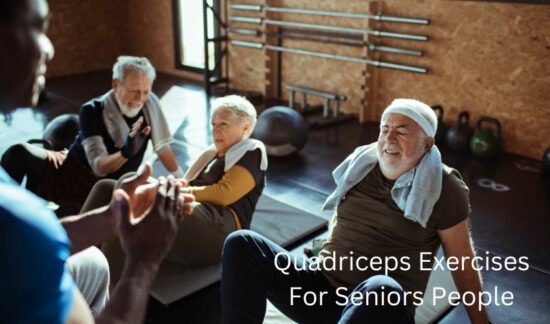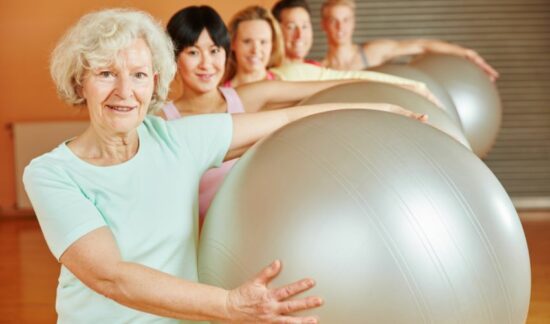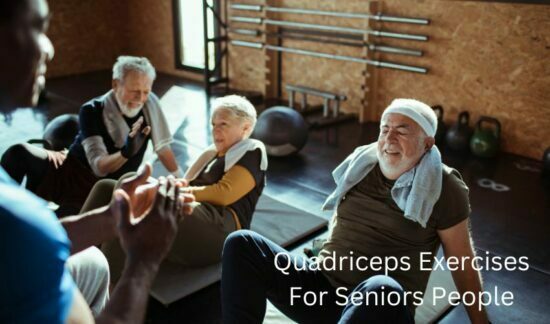Your legs are used in practically all of the tasks you do during the day, such as jogging, playing tennis, and carrying groceries.
Your legs are your largest muscular group.
They provide you support and help you keep pushing forward.
In a sense, they might be thought of as the building blocks of your body.
The loss of muscular mass and flexibility is a natural consequence of aging.
It’s possible that a lack of physical activity or joint problems are to blame for this.
But you need to do more than just walk if you want to keep your legs strong and prevent yourself from losing too much muscle as you get older.
It is essential to include strength training and functional movements in your workout routine if you want to keep or build your muscle mass, improve your balance and coordination, and lessen any joint pain you may be experiencing.
Strength training should be performed two to three times per week by seniors, with each session focusing on working all of the major muscle groups.
When it comes to building strength, working out your legs is a vital component of the equation.
You will see an increase in the strength and flexibility of your muscles if you consistently engage in weight training and stretching.
This is the case regardless of age.
Your lower body will benefit from these five workouts in terms of both strengthening and increasing mobility.

Benefits.
Quadriceps exercises, also known as quad exercises, can be very beneficial for seniors. Here are,
- Quadriceps exercises can help seniors maintain and improve their mobility, which can reduce the risk of falls and other injuries.
- Strong quadriceps muscles can help seniors maintain better balance, which can also reduce the risk of falls.
- Seniors who suffer from knee pain or arthritis may benefit from quadriceps exercises, as strengthening the quadriceps can help to support the knee joint and reduce pain.
- By maintaining strong quadriceps muscles, seniors can continue to perform daily activities independently for longer periods of time.
- Quadriceps exercises can help seniors maintain muscle strength, which can help to reduce the risk of muscle atrophy and weakness.
- Strengthening the quadriceps can also help seniors maintain good posture, which can reduce the risk of back pain and other issues.
1.Stability Ball Squats Against The Wall
Squats are the most effective exercise for building strength in your hips, glutes, and quads. They are also one of the most fun exercises to do.
It will be easier for you to refine your technique if you practice wall squats with the support of a stability ball while you are working against the wall.
This is due to the fact that the stability ball provides cushioning for your lower back and directs your squats to the appropriate depth.
Additionally, the stability ball helps you with the explosive movement that occurs as you come up from the squat position.
Wall and stability ball are required pieces of equipment.
Hips, glutes, quadriceps, and the lower back were all addressed during this exercise.
1. Stand.
Position your feet so that they are shoulder-width apart, and lean against a stability ball that is pressed up against a wall with your shoulder blades.
It should go all the way down to the small of your back.
Lean back into the ball, and take a little step away from the wall in the direction opposite of the lean.
Make sure that your weight is distributed evenly into both of your heels, and that you retain the pressure on the ball of your foot.
You have the option of lowering your hands to your sides and keeping them there, or extending them in front of you.
Maintain a tall erect stance while engaging your core and relaxing your shoulders.
This is the point from which you will begin.
2. Inhale.
Put your body into a squat position while maintaining pressure on the ball. This will ensure that it continues to provide protection for your lower back.
Stop when the angle formed by your knees is 90 degrees and, when viewed from the side, it appears like you are sitting in a chair that does not exist.
Maintain an erect posture during the entire exercise and keep your abdominal muscles engaged.
Maintain this position for the duration of one count.
3. Exhale.
Launch yourself upward through the heels and return to the starting posture.
4. Perform.
15 repeats.Perform up to three or four sets.

2. Lunges At A Stationary Position
The same muscle groups are worked during a stationary or static lunge as they are during a typical lunge.
But in this scenario, you won’t be engaging in that explosive movement because you’ll be standing in the same place the entire time with your feet planted firmly on the ground.
The reason that stationary lunges are better for your knees is that they allow you to keep your form without the movement that could end up placing additional strain on your joints.
Equipment needed: none.
Quadriceps, glutes, hamstrings, and calves were all worked during this exercise.
1. Start.
bringing your knees close together.
Take one big step to the left and lift the heel of your left foot off the ground so that just your very tipsy toes are touching the ground.
Put all of your weight on your right heel, and make sure your right quadriceps are engaged.
Your upper body should be in a tall, upright position while your core should be engaged. At the same time, your shoulders should be back and relaxed.
Always keep your gaze fixed straight ahead of you to prevent your shoulders from rounding inward and your chest from collapsing.
This is the point from which you will begin.
2. Inhale.
Reduce your height till the left knee of your left leg is approximately two to three inches off the ground.
As you descend, the right knee should bend to a right angle of ninety degrees as you descend.
In the event that your right knee goes past your toes, you should take a further step backward with your left leg.
It is not appropriate for your toes to extend further than your bent knee.
3. Exhale.
Bring yourself back up to the starting position by driving through your right heel.
You should extend your leg completely, but be careful not to hyperextend your knee.
When you have reached the highest point of your lunge stance, contract your left glute by applying pressure.
4. Perform.
10 reps for three to four sets, and then swap legs after each set.
As your strength improves, switch to using dumbbells and/or increase the number of times you repeat the exercise.
3. Abductor.
The hips have a propensity to become very tight very quickly.
It is essential to maintain a regular stretching routine for your hips in order to prevent any reduction in the range of motion that is possible in your hip joints.
Abductor machine is a necessary piece of equipment.
Abductors, hips, the core, and glutes were the muscles that got a workout.
1. Spread.
You can sit down comfortably because the machine’s legs have been moved outward.
Place yourself on the abductor machine so that you are facing the stack of weights, and choose an amount of weight that is good for you.
2. Place.
Put the highest point of the footrests to support your feet.
Raise the lever, then move it toward you while bringing your knees together.
When you are executing this exercise, you should avoid leaning back on the backrest so that you can focus on working just your abductors and glutes.
Adjust your position such that your butt is practically hanging off the edge of the seat.
Put some effort into engaging your core so that you can keep your posture straight and sit up straight.
If you feel the need to do so, you are free to grab onto the handles.
This is the point from which you will begin.
3. Exhale.
Your abductors and glutes should be pushed as far apart as possible while you perform this exercise.
Hold. This position counts for two different things.
The upper part of your body should not move at all as you perform this exercise.
Your glutes and abductors are the only muscles that should be working.
4. Inhale.
Come return to the starting position while releasing the tension that you’ve been holding in your inner thighs and abductors in a calm and controlled movement.
You should always sustain tension, so don’t let the weights fall back down once you’ve lifted them.
Repeat your pushes in the opposite direction as soon as the weight is a half inch away from the stack.
5. Perform.
15 repeats.
Perform up to three or four sets.
4. Lateral Band Walk.
This exercise is quite similar to the abductor exercise that was done before.
On the other hand, rather than using weight and remaining still, you will be working against resistance, which will force you to keep moving.
Your hips, glutes, and inner thighs will gain a significant amount of mobility and strength as you perform this banded walk.
The necessary piece of equipment is a resistance band.
Gluteal, abductor, and quadriceps muscles were all exercised during this exercise.
1. Grab.
a band of resistance that has the right amount of thickness.
Step onto the band so that it is positioned underneath the instep and the heel of your shoes while holding onto it at a height that is around waist height.
2. Stand.
a distance of one shoulder’s width apart, with your knees bent slightly.
Maintain a moderate amount of tension on the band using your hands.
Make sure that your weight is evenly distributed in your heels.
Your upper body should be relaxed, and you should stand tall with your core engaged.
This is the point from which you will begin.
3. Continuously.
Maintain your breathing, and move your right foot laterally to the right while taking a large step.
When you land, be sure that you plant your right foot firmly on the ground.
Make sure that your feet are lifted up, and that you are not dragging them along the ground.
Maintain this wide posture for the duration of one count.
4. Lift.
to your right side without dragging your left foot.
You should only move your left foot a shoulder’s width to the right of your right foot when you do this.
You will be in the same position as when you started.
Imagine taking one step that is wider than your shoulder.
5. Step.
Step forward for a distance of fifty feet, and then take a fifty-foot lateral step to the left.
5. Leg Press.

This exercise challenges your leg’s total strength because it requires both explosive power and control at the same time.
Leg press machine is a necessary piece of equipment.
Quadriceps, hamstrings, calves, and glutes were all worked during this exercise.
1. To begin,
sit down in the leg press machine with your heels underneath you.
on the deck of the ship.
They should be spaced about the width of a shoulder apart, with both feet in a straight line.
You should have a modest bend in both knees, and they should be in line with your ankles.
Note that you should not completely lock out your knees when executing this exercise; rather than your joints, you want to force your muscles to do all of the work.
2. Maintain,
a strong core contraction while relaxing the top part of your body against the back pad.
Because doing so can generate unwelcome strain in your lower back, you should avoid arching your back while you are in this position.
Put your focus inward.
If you feel the need to do so, you are free to grab onto the handles.
This is the point from which you will begin.
3. Inhale.
Turn the key to unlock the safety lock.
You need to descend the platform toward you in a calm and controlled manner while bending your knees so that the angle formed by both of your knees is equal to ninety degrees.
Slide your feet up higher on the platform if you notice that your knees are beginning to go past your toes.
It is important that you bear the entirety of your weight on your heels.
When viewed from the side, you ought to appear to be assuming a squat position.
Your chest should be in line with your quadriceps at this point.
Maintain this position for the duration of one count.
4. Exhale.
You should be driving through your heels and pushing the platform back up to your starting position while keeping your knees from locking out.
You want to keep them bent at an angle of roughly 10 degrees.
5. Perform.
12 repeats.
Perform up to three or four sets, increasing the weight as you are able to.
Safety and Precautions
While quadriceps exercises can be beneficial for seniors, it’s important to take some precautions to ensure safety during exercise. Following are,
- Before starting any exercise routine, seniors should consult with their doctor to ensure they are healthy enough to engage in physical activity.
- Seniors should start with low-intensity exercises and gradually increase intensity as their strength and endurance improves.
- Proper form is important to avoid injury. Seniors should perform exercises with proper alignment, using a stable chair or wall for support if necessary.
- Seniors should use safe and stable equipment, such as a sturdy chair or a resistance band that is appropriate for their fitness level.
- Seniors should avoid overexerting themselves and take breaks if they feel tired or fatigued.
- Watch for Pain or Discomfort: Seniors should stop exercising immediately if they experience any pain, discomfort, or dizziness.
- Seniors should stay hydrated by drinking water before, during, and after exercise.
Bottom Line.
Lower body strength training is beneficial for improving your balance and agility and may potentially reduce the risk of fractures.
It is a natural consequence of aging to lose some of the muscular prowess that one previously possessed in their younger years.
However, engaging in strength training twice or three times per week in addition to maintaining an active lifestyle can promote both the growth of muscles and their mobility.
This will keep you strong regardless of how old you get.
FAQs
Squats are the most effective exercise for building strength in your hips, glutes, and quads. They are also one of the most fun exercises to do.
Squats.
Squats are a great exercise for targeting the quadriceps, and they may be easily adapted to meet the requirements and address the concerns of older adults. Squats contribute to increased bone density in part because they are weight-bearing workouts. In addition to working a number of other significant muscle groups, including the hamstrings and the gluteal muscles, this exercise also works the abdominal muscles.
